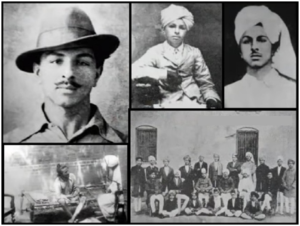Bhagat Singh: A Revolutionary Icon
Bhagat Singh: A Revolutionary Icon

Early Life:
Bhagat Singh, born on September 28, 1907, in Banga, Punjab (now in Pakistan), was a prominent Indian freedom fighter and a symbol of courage and sacrifice.
- He hailed from a patriotic Sikh family deeply influenced by the freedom struggle.
- His father, Kishan Singh Sandhu, and uncle, Ajit Singh, were active participants in the fight for India’s independence.
- Bhagat Singh’s early exposure to this environment instilled in him a strong sense of nationalism and a commitment to the cause of freeing India from British colonial rule.
- Bhagat Singh initially attended a village school for a few years.
- He later enrolled in an Anglo-Vedic school in Lahore, which was run by the Arya Samaj.
Impact of National Movement:
- In 1923, Bhagat Singh gained admission to the National College in Lahore.
- The National College had been founded by the Indian independence activist LalaLajpat Rai.
- The JallianwalaBagh massacre in 1919, the Non-Cooperation Movement led by Mahatma Gandhi, and the Simon Commission’s undemocratic composition deeply affected young Bhagat Singh.
- He witnessed the brutality of British rule and felt compelled to take a more radical stance in the struggle for independence.
Involvement in the Freedom Struggle
- In 1924, Bhagat Singh joined the Hindustan Republican Association (HRA), led by SachindranathSanyal and organized by Chandra Shekhar Azad.
- Under the influence of the HRA, Bhagat Singh embraced the idea of armed revolution against British imperialism
- In 1925, he returned to Lahore and, with his colleagues, founded the militant youth organization Naujawan Bharat Sabha.
- In 1927, Bhagat Singh was arrested on charges related to the Kakori Case, accused of writing an article under the pseudonym Vidrohi (Rebel).
- In 1928, he renamed the Hindustan Republican Association to the Hindustan Socialist Republican Association (HSRA).
- In 1930, when Chandra Shekhar Azad was shot, the HSRA disbanded, and Naujawan Bharat Sabha took its place in Punjab.
The Simon Commission
- The Simon Commission was formed by the British Government to assess the political situation in India.
- It was headed by Sir John Simon but did not include any Indian members, leading to widespread boycott and protest.
- LalaLajpat Rai’s Protest and Injury
- On October 30, 1928, the Simon Commission visited Lahore.
- Lala Lajpat Rai led a silent march against the commission.
- In an attempt to disperse the protesters, Superintendent of Police James A. Scott ordered a lathi charge, resulting in severe injuries to Lala Lajpat Rai.
- LalaLajpat Rai eventually succumbed to his injuries, passing away on November 17, 1928.
- Bhagat Singh’s Revenge Plot
- Bhagat Singh, along with fellow revolutionaries Sukhdev and Rajguru, sought to avenge Lala Lajpat Rai’s death.
- Their target was the Superintendent of Police, James A. Scott, who had ordered the lathi charge.
- On December 17, 1928, Bhagat Singh mistakenly identified British Police Officer John Saunders as James A. Scott.
- Bhagat Singh shot and killed John Saunders as he was leaving the District Police Headquarters in Lahore.
- Escalation and Fleeing
- Following the killing of John Saunders, a massive search operation was launched to apprehend Bhagat Singh.
- To evade capture and avoid recognition, Bhagat Singh had to flee from Lahore and took measures such as shaving his head and beard.
Central Assembly Bombing
- On April 8, 1929, Bhagat Singh and Batukeshwar Duttthrew non-lethal smoke bombs in the Central Legislative Assembly in Delhi in 1929 to protest against repressive laws.
- This act aimed to draw attention to the cause of Indian independence.
- Despite the chaos and confusion that followed, Singh and Dutt did not immediately flee but instead shouted the popular slogan ‘Inquilab Zindabad!’ (Long Live the Revolution!).
- They were eventually arrested and subsequently moved to various jails in Delhi.
Lahore Conspiracy Case and the Hunger Strike
- After a preliminary hearing in May, the trial for the Assembly bombing case began in the first week of June.
- On June 12, 1929, Bhagat Singh and BatukeshwarDutt were sentenced to life imprisonment for causing explosions likely to endanger life and acting unlawfully and maliciously.
- In 1929, associates Sukhdev, Kishori Lal, and Jai Gopal were arrested in connection with bomb factories in Lahore and Saharanpur.
- The police investigation linked the murder of John Saunders, the Assembly bombing, and bomb manufacturing to Bhagat Singh and his comrades.
- Bhagat Singh, who considered himself a political prisoner, led demands for equal treatment for Indian prisoners compared to European prisoners.
- The political prisoners protested for equal food standards, clothing, toiletries, access to books, and newspapers.
- A hunger strike was initiated by Singh and other prisoners, and the government’s attempts to break the strike failed.
- Due to the nationwide popularity of the hunger strike, the government expedited the Lahore Conspiracy Case.
- The trial for the Lahore Conspiracy Case began on July 10, 1929.
Martyrdom:
- On March 23, 1931, Bhagat Singh, Rajguru, and Sukhdev were executed by hanging in Lahore Central Jail.
- Their sacrifice galvanized the Indian independence movement, and they became martyrs who inspired generations to come.
Books Written by Him:
- Bhagat Singh penned several thought-provoking essays and articles during his time in prison.
- Some of his notable works include “Why I am an Atheist” and “To Young Political Workers.”
- These writings reflected his ideological evolution and commitment to a secular and inclusive vision of India’s future.